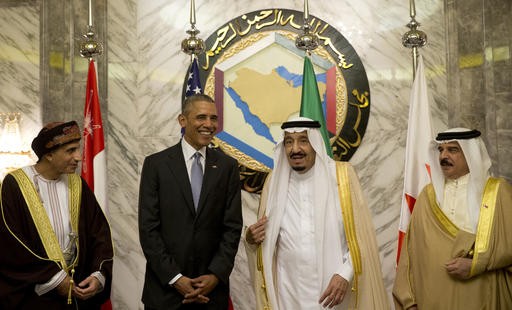Popular Reads
Top Results
Can't find what you're looking for?
View all search resultsPopular Reads
Top Results
Can't find what you're looking for?
View all search resultsMoody's downgrades Saudi Arabia on lower oil prices
Change text size
Gift Premium Articles
to Anyone
 From left, Oman's Deputy Prime Minister Fahd bin Mahmoud al-Said, Saudi Arabia's King Salman, President Barack Obama and Bahrain's King Hamad bin Isa al Khalifa participate in the Leaders Photo with theses and other Gulf Cooperation Council leaders at the Diriyah Palace during the Gulf Cooperation Council Summit in Riyadh, Saudi Arabia, on April 21. The president is on a six day trip to strategize with his counterparts in Saudi Arabia, England and Germany on a broad range of issues with efforts to rein in the Islamic State group being the common denominator in all three stops. (Associated Press/Carolyn Kaster)
From left, Oman's Deputy Prime Minister Fahd bin Mahmoud al-Said, Saudi Arabia's King Salman, President Barack Obama and Bahrain's King Hamad bin Isa al Khalifa participate in the Leaders Photo with theses and other Gulf Cooperation Council leaders at the Diriyah Palace during the Gulf Cooperation Council Summit in Riyadh, Saudi Arabia, on April 21. The president is on a six day trip to strategize with his counterparts in Saudi Arabia, England and Germany on a broad range of issues with efforts to rein in the Islamic State group being the common denominator in all three stops. (Associated Press/Carolyn Kaster)
Saudi Arabia's credit rating has been downgraded by Moody's because of the long and deep slump in oil prices.
Moody's Investors Service said Saturday that it also downgraded Gulf oil producers Bahrain and Oman. It left ratings unchanged for other Gulf states including Kuwait and Qatar.
Saudi Arabia is the world's largest oil exporter. Moody's cut the country's long-term issuer rating one notch to A1 from Aa3 after a review that began in March.
Crude prices fell from more than $100 in mid-2014 to under $30 a barrel in February, although they have recovered into the mid-$40s. Benchmark international crude settled Friday at $47.83 a barrel.
"A combination of lower growth, higher debt levels and smaller domestic and external buffers leave the Kingdom less well positioned to weather future shocks," Moody's said in a note.
Moody's lowered Oman to Baa1 from A3 and Bahrain to Ba2 from Ba1. The ratings agency did not downgrade Kuwait, Qatar, the United Arab Emirates or Abu Dhabi, but it assigned a negative outlook to each.
Oil prices slumped because of production that grew faster than demand. Surging production from shale operators in the United States contributed to the glut. So did the Organization of Petroleum Exporting Countries, which decided in November 2014, several months after prices began falling, to continue pumping rather than give up market share. (ags)









